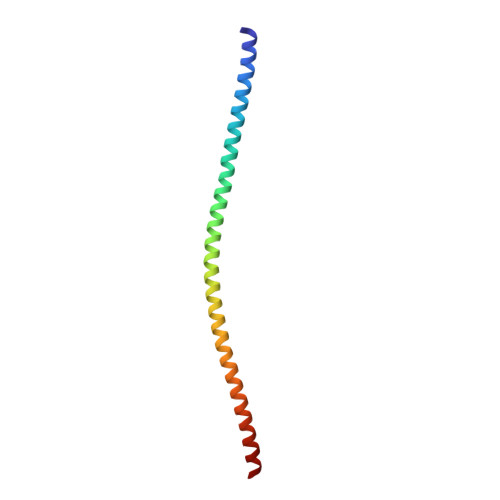A Coiled-Coil Motif that Sequesters Ions to the Hydrophobic Core.
Hartmann, M.D., Ridderbusch, O., Zeth, K., Albrecht, R., Testa, O., Woolfson, D.N., Sauer, G., Dunin-Horkawicz, S., Lupas, A.N., Alvarez, B.H.(2009) Proc Natl Acad Sci U S A 106: 16950
- PubMed: 19805097
- DOI: https://doi.org/10.1073/pnas.0907256106
- Primary Citation of Related Structures:
2WPQ, 2WPR, 2WPS, 2WPY, 2WPZ, 2WQ0, 2WQ1, 2WQ2, 2WQ3 - PubMed Abstract:
Most core residues of coiled coils are hydrophobic. Occasional polar residues are thought to lower stability, but impart structural specificity. The coiled coils of trimeric autotransporter adhesins (TAAs) are conspicuous for their large number of polar residues in position d of the core, which often leads to their prediction as natively unstructured regions. The most frequent residue, asparagine (N@d), can occur in runs of up to 19 consecutive heptads, frequently in the motif [I/V]xxNTxx. In the Salmonella TAA, SadA, the core asparagines form rings of interacting residues with the following threonines, grouped around a central anion. This conformation is observed generally in N@d layers from trimeric coiled coils of known structure. Attempts to impose a different register on the motif show that the asparagines orient themselves specifically into the core, even against conflicting information from flanking domains. When engineered into the GCN4 leucine zipper, N@d layers progressively destabilized the structure, but zippers with 3 N@d layers still folded at high concentration. We propose that N@d layers maintain the coiled coils of TAAs in a soluble, export-competent state during autotransport through the outer membrane. More generally, we think that polar motifs that are both periodic and conserved may often reflect special folding requirements, rather than an unstructured state of the mature proteins.
Organizational Affiliation:
Department of Protein Evolution, Max Planck Institute for Developmental Biology, 72076 Tübingen, Germany.
















